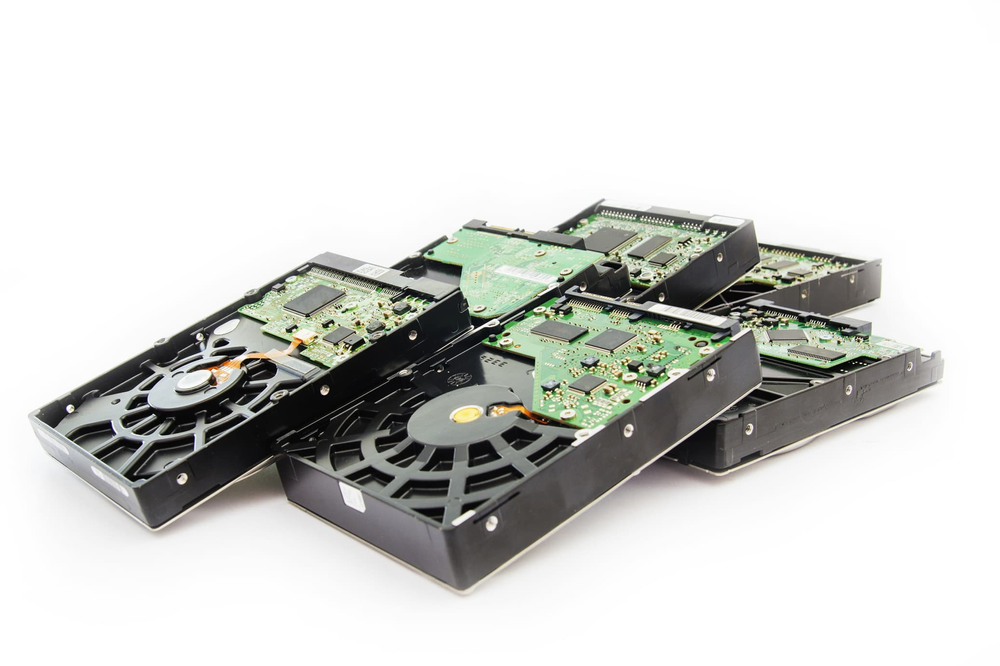If you’re looking to ensure something is always available, it’s helpful to have redundant systems. Emergency generators keep the lights on when the power is cut, safety lines keep workers safe if a ladder fails and, naturally, backup files allow you to recover computer system following a data loss event. The same is true in RAID data recovery.
RAID storage is based on a "Redundant Array of Independent Disks" – hence the name. These multi-drive devices help keep your data available by making sure your storage includes a built-in fail-safe.
This article covers:
- How data striping works
- What disk mirroring does to help recover data
- What the different RAID data recovery configurations are
- Why RAID 10 data recovery is most secure
How RAIDs use data strips and stripes
When you store a lot of data, your systems use data striping for optimum performance. Imagine information on a hard disk as stackable toy blocks. Each piece of data you input is one block. As you add information, your computer stacks these "blocks" on top of one another, creating a data tower called a "strip." In a RAID device, you have more than one disk, and the series of hard disks and their strips are called a stripe.
Disk striping uses strips and stripes to allow applications to run as fast as possible. It does this by spreading the information out making it easier to find. Think of it this way: Imagine a child has all of his toys stored in one large toy box. To find the toy he wants, he has to dig through all of the toys. But if the toys are organized by type into several smaller boxes, the child can scan for the type of toy he wants first, allowing him to find specific toy faster in that smaller box.
Now apply that approach to applications transferring data to and from your computer. The input/output (I/O) processes can slow down a computer if the information is all stored in a single place. Disk striping speeds up those processes by allowing two disks to work simultaneously because neither holds all the information for a single application. By spreading, or striping, the data across several disks, the applications can search the hard disks quickly to find what they need during their requests.
Disk Mirror on the Hard Drive
A disk mirror is a copy of files either on a website or a server. For backup purposes, a disk mirror is a copy of everything on your hard disk. This copy includes your files as well as your applications.
Synchronous mirroring copies data continuously as you make changes. This process increases an application's I/O because every time you add new information, the application sends a message to the hard disk. As it transfers the new data, it also requests the old information's replacement.

How RAID 10 works by using disk striping and mirroring
Disk striping spreads information across a variety of hard disks. Disk mirroring makes copies of the information spread across those hard disks. RAID stores information across multiple disks to improve performance by speeding up the I/O operations. Let’s break down the acronym and dive a bit deeper.
Redundant – By using additional disks, RAID makes multiple copies of data speed up the IO operations or to add reliability.
Array – Disk arrays create a system that can stand unreliability of one or more disks in the array.
Independent – Keeping the hard disks independent increases fault tolerance, allowing data to be read from the RAID massive in the event of a single disk outage. (The original definition of RAID referred to inexpensive disks, which pointed to the ability to create a reliable fast storage from any devices you have.)
Disks – Multiple disks allow disk striping to create copies of data across the storage areas in a way that speeds up both saving and recovering the information.
Data recovery for a RAID system combines these two into a single process. Whether it’s RAID 1 or RAID 10, both use mirroring and disk striping to establish a strong foundation for data recovery.
Leveling Up: What RAID Levels Mean to Data Storage
When you're considering a RAID data recovery service, you need to understand what the numbers mean and how the product's configuration can meet your needs (or not). Since different RAID array data recover configurations mean the disk striping and disk mirroring interact differently, you want to understand the two primary categories of RAID level.
Standard RAID Levels
RAID 0 data recovery uses disk striping but no mirroring. Therefore, while it offers peak performance, it does not allow for recovery which means you can lose all your data in one event.
RAID 1 data recovery is basic disk mirroring where you have copies of all your data in one big bucket. This has a recovery but slows down your applications.
RAID 3 data recovery uses disk striping and incorporates parity. Parity acts like a cached copy of a document. It determines whether the data transmission lost or wrote over information. This process is especially helpful when you are using synchronous disk mirroring. Thus, you would have Disk 1 containing all Block A's information, Disk 2 containing all Block B's information, and Disk 3 containing all Black C's information. This arrangement is like having three separate boxes of the same type of toy all stacked on top of one another. Disk 4 has all the parity (mirrored and error checked) files. This allows applications to get the information they need quickly, even if it slows down the mirroring process. RAID 3 works most efficiently for single-user systems with long record applications.
RAID 5 data recovery and RAID 6 data recovery uses block-level striping and parity. Instead of creating a single strip for each drive, RAID 5 spreads the blocks across the disks. By separating the blocks across different disks, operations can continue even if a single disk fails. This means, for example, that Disk 1 has information about Block A, Block B, Block C, and Block D while Disk 2 has the second stack of Block A, Block B, Block C, and Block D. This arrangement stacks one bucket of each type of toy. Each strip also has one of the parity blocks. By spreading the different types of data across the disks, you ensure only a small percentage of loss to any given block. However, when applications send I/O requests, the information takes longer to send and receive slowing everything down.
Nested RAID Levels
Nested levels are combinations of the six types of RAID listed above:
RAID 10 data recovery (RAID 1 + RAID 0) is a combination of RAID 1 and RAID 0. RAID 10 stripes the information and then makes a copy of the stripes. A RAID 10 configuration first divides the information across the disks, and then it copies the stripes.
RAID 01 (RAID 0 + RAID 1) makes a full copy of the disk and then stripes it. Since the striping occurs after the mirroring, all of the information is on both the disks rather than split up between the disks.
Why RAID 10 provides the best data recovery
The hardest thing to understand when it comes to RAID recovery is that even though you have the same number of disks, the order of the processes changes the ability to recover information.
For data recovery, RAID 10 provides the best recovery option for the storage used. Despite RAID 10 and RAID 01 being inverse versions of the same process, RAID 10 secures data better.
Mirroring makes two copies of the same thing. Striping allocates data across multiple disks. If you're using two disks, then the difference between RAID 10 and RAID 01 appears negligible. However, the more hard disks you add to your environment, the safer RAID 10 becomes.
If you start with ten disks for storage, the data allocation and mirroring changes.
RAID 01 starts by making a full copy of your information. Then, it stripes the disks. Since RAID 01 also uses parity, the updated allocation for optimization goes back and forth. Thus, you get one mirrored group of a set of striped disks.
RAID 10 stripes the data first, then makes copies. By striping the data first, RAID 10 makes multiple striped disks then mirrors them individually.
This process makes more sense when applying it to a set of ten disks. A RAID 01 with ten disks makes a copy of everything then optimizes the information. This leaves you with two groups of five disks.
A RAID 10 optimizes the disks then makes an individual copy of each disk. This process leaves you with five groups of two disks. By giving you more copies of the information, a RAID 10 provides better recovery because you can have multiple disks fail without losing all your information.
Recovery is Not Backup
RAID provides better accessibility and much more reliable storage for your data, not backup. RAID may incorporate parity. Parity copies data and ensures a complete copy of that data as part of the transmission. When you want to recover necessary changes you've made, you want this error checking. However, if your operating system corrupts your data, parity copies the corrupted data as well. If one of your disks fails, RAID holds the fort until you can fix the problem.
Acronis Backup supports RAID storage as a local drive, giving you the best of both recovery and backup. But unlike the parity of RAID, with Acronis Backup the only data is information you purposefully save to the backup – and since you can store multiple versions of your backup, if you determine that your data is corrupted, you can grab a clean copy from a backup version made before the corruption occurred.
About Acronis
A Swiss company founded in Singapore in 2003, Acronis has 15 offices worldwide and employees in 50+ countries. Acronis Cyber Protect Cloud is available in 26 languages in 150 countries and is used by over 21,000 service providers to protect over 750,000 businesses.



